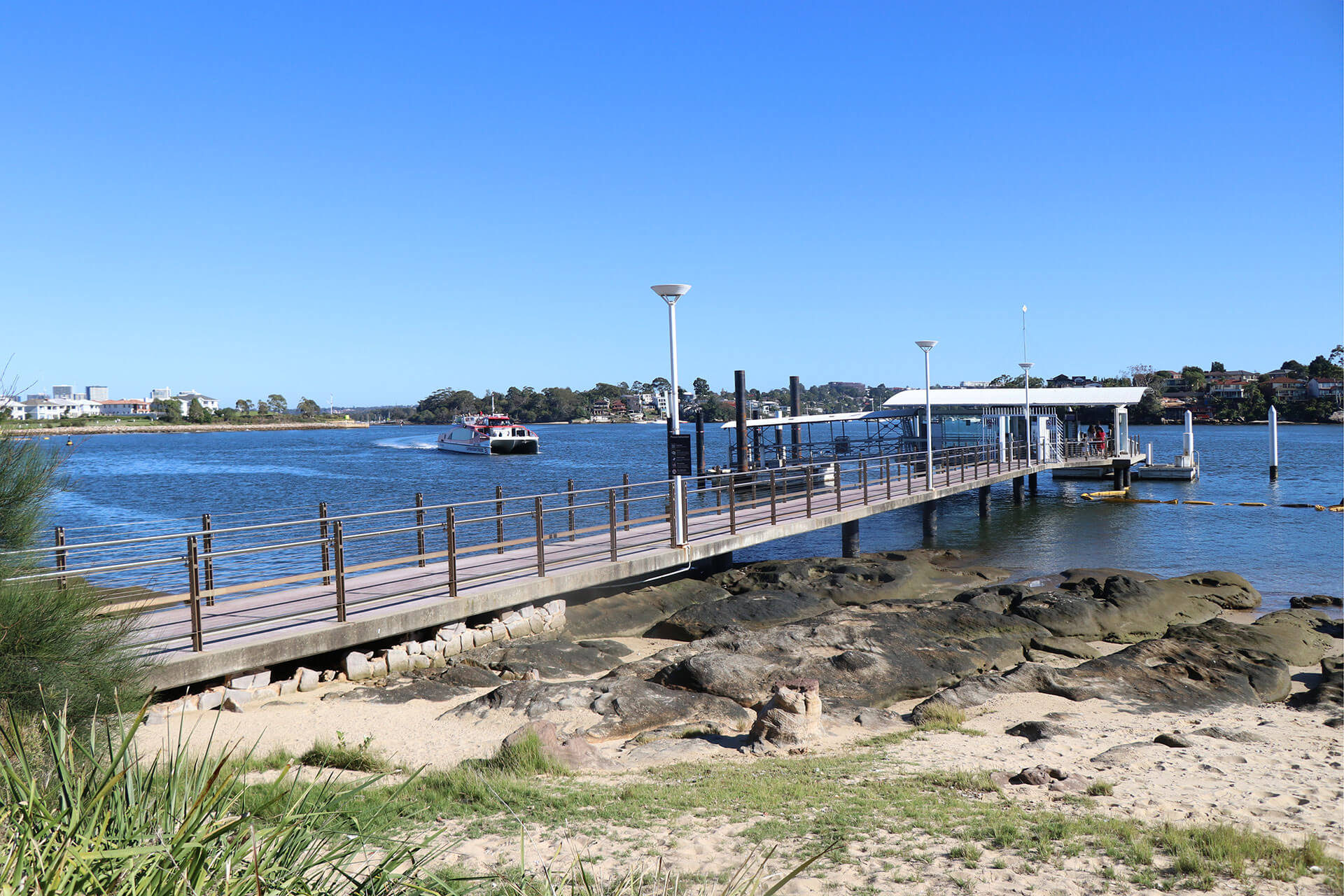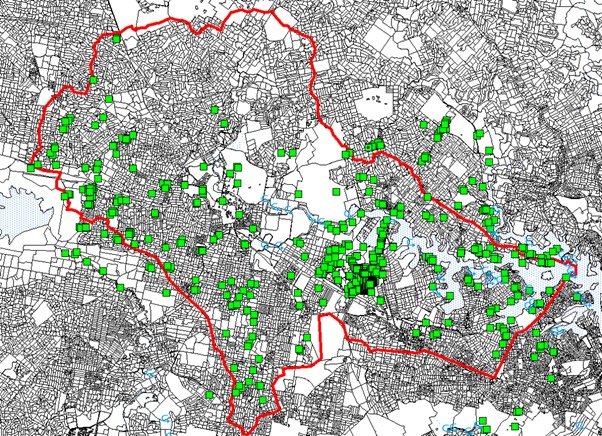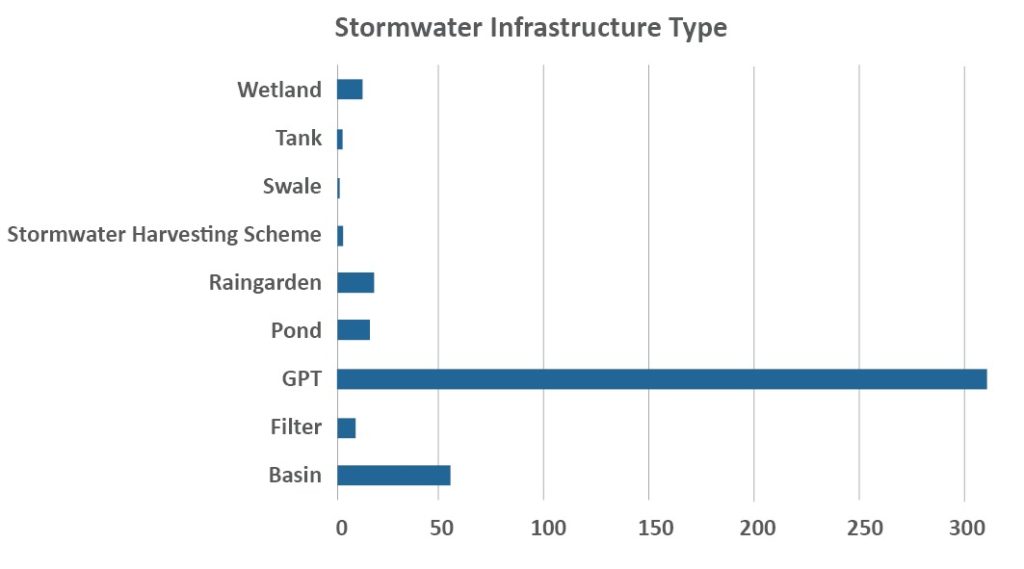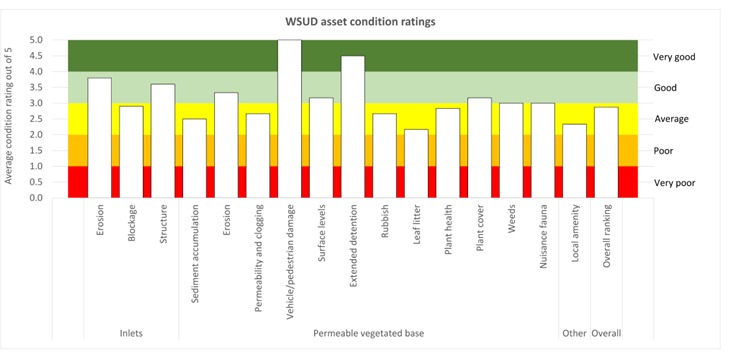5. Reduce stormwater runoff
Overview
Stormwater runoff has the potential to contribute large volumes of pollution into our waterways. We can combat this through the adoption of practices such as Water Sensitive Urban Design and a catchment-wide approach to reducing runoff reaching our waterways.
Recommendation
Adopt a regional approach to the installation, maintenance and reporting of stormwater infrastructure and water sensitive urban design (WSUD) infrastructure.
Timeframe
Ongoing.
Lead Agency
City of Parramatta and Sydney Water.
Current Measure
The workplan, as agreed by the subcommittee, is progressed on time and in budget.
Status Update
There are currently ten Councils, Transport for NSW, Roads and Maritime Services, Sydney Water and Sydney Olympic Park Authority (SOPA) that sit on a Stormwater Subcommittee which is dedicated to adopting a regional approach to the installation and maintenance of water sensitive urban design (WSUD) and stormwater infrastructure for the catchment. The annual workplan for the committee is broken down into four areas:
- Evidence base: this data is vital to prioritise future work and to model the effectiveness of current investment and stormwater management.
- Capacity building: uplift skills and knowledge within member organisations to address Step 5 outcomes.
- Funding sustainable stormwater management: additional sustainable funding for capital costs and operational costs of stormwater management, to meet the objectives of Steps 4 and 5.
- New tools and resources: develop supporting materials and explore new cross-organisational programs.
1. Developing the evidence base:
- We are auditing existing water sensitive urban design assets in the public and private realm to understand effectiveness of operations.
- Collecting information on location, condition and maintenance program of all gross pollutant traps, raingardens, wetlands and on-site stormwater devices across the Parramatta River catchment.
- Further information in PDF attachment (at end of this document).
2. Capacity Building:
- Share practices to uplift skills and knowledge within member organisations to build and manage green infrastructure that will treat stormwater before it enters our river and impacts on swim sites. Publish tools, research, share examples of projects and on-ground works.
- Developing educational materials for landholders and strata on management of stormwater management infrastructure on their lands. Including factsheets, webinars and videos.
3. Funding sustainable stormwater management:
- Investigating the efficacy of current investment in stormwater management.
- Reviewing council expenditure on stormwater infrastructure with a goal to adopt a regional outlook on investment. Working with stakeholders to identify sustainable funding opportunities.
- Regional WSUD compliance program.
4. New tools and resources:
- Ongoing implementation of the Litter Workplan.
- Developing standard WSUD operational and maintenance requirements for public and private WSUD assets.
- Standardised covenants and restrictions for stormwater management infrastructure
- Incorporating WSUD where appropriate for council areas, and improved stormwater management responses on roadways and parklands.
The Stormwater Subcommittee continues to meet on a regular basis. The priorities of the group centre around improving the capacity of councils to build and manage green infrastructure that will treat stormwater before it enters our river and impacts on swim sites. The Delivery Engine is working on pathways to fund more stormwater treatment infrastructure, as well as prioritising where infrastructure is required in the catchment.
SMART Places Acceleration Program – Smarter Cleaner Sydney Harbour for smart sensors in stormwater management
- The Smarter, Cleaner Sydney Harbour pilot will help authorities explore how smart technologies can help keep Sydney Harbour clean and healthy.
- The PRCG is partnering with CSIRO and Sydney Coastal Councils Group (SCCG) to conduct a larger trial of this technology in Sydney. The project involves the installation of approximately 80 sensors and cameras on GPTs and waterways across Sydney Olympic Park and seven local government areas within the Greater Sydney Harbour catchment, as well as the development of a web-based analysis, decision support and reporting tool.
- The project is supported through the NSW Smart Places Acceleration Program with a $545,000 grant provided by the NSW Digital Restart Fund. SOPA is acting as the NSW state agency co-partner on this project given Sydney Olympic Park has one of the highest concentrations of GPTs in Sydney.
- The project commenced in December 2022 and is expected to be completed in early 2024. The outcomes of the project will be considered in the preparation of the Greater Sydney Harbour Coastal Management Program as well as the implementation of the Greater Sydney Harbour Regional Litter Prevention Strategy.
- More information: www.sydneycoastalcouncils.com.au/projects/smarter-cleaner-sydney-harbour/
Stormwater Audit Results
Water Sensitive Urban Design (WSUD) is the broad collection of approaches to manage stormwater quality and runoff volumes to protect receiving waterways and create more green areas for the community. WSUD assets are held in public ownership and managed by council or the state government, or they are on-lot, that is held in private ownership to be operated and maintained by the individual.
Public Assets
In 2020 member councils and agencies were surveyed on publicly held WSUD assets. The committee is working to overcome the issues identified in the survey and to increase the catchment area in which stormwater is treated prior to its release to the Parramatta River.
Private Assets Audit
In 2022 an audit of private stormwater devices was undertaken. The purpose of the audit was to:
a) understand how systems are being managed and maintained;
b) gain insight into property owners/tenants’ understanding of these stormwater management devices.
Fifty properties across seven LGAs were included in the audit, covering 254 assets. The audit report noted a number of specific issues, including poor property owner awareness of assets, poor design and construction and lack of ongoing maintenance.
The results of these inspections reveal that WSUD and OSD assets are working, but often ignored or not maintained. They are in general in average condition, and without a maintenance plan and budget, and may in the long term be a risk to the overall health of the river. These assets are providing some benefit to properties and lives from a flood management perspective, but this could be greatly improved with maintenance.
The auditing results of a total of 48 On-site Stormwater Devices (out of 254 assets across the 50 properties) were that overall, the OSD assets are functional (but only partially) but have very limited maintenance. It should also be noted that all OSD systems inspected were 15 years old or less, and that over that time, an unmaintained OSD will be increasingly likely to fail, leading to increased downstream flooding.
Of the 254 assets audited across the 50 properties, 171 were categorised as WSUD assets, and 18 included some type of vegetated filter. The rating of various parameters for these 18 WSUD assets is shown below.
In terms of the awareness and perception of property owners and strata managers, the main results from this project are shown below:
- Only 20% of assets are being maintained according to property owners
- 77% of property owners had no idea what these assets did (or did not respond)
- 15% knew when maintenance had been completed, and 9% stated that maintenance was completed in the past 12 months
- Just 3 of 50 property owners were able to estimate the costs of maintenance
- 5% of OSD devices had OSD name plates, and
- 14% of assets did not exist.
The committee is using the data gathered to focus efforts on policy change, education, alternative maintenance models, improved compliance and reporting and enforcing the use of covenants across the catchment.
Progress Timeline
March 2024 to May 2025
- Compliance: The March 2025 GTSR Blitz involved 23 councils and over 1,000 site inspections. NSW EPA and partners used it for broader compliance checks. New educational materials were developed, but earlier implementation is needed. MoUs were shared to formalise council roles and reporting.
- WSUD Uplift Project: PRCG is aligning council planning controls and compliance processes, based on Blacktown’s model. Focus areas include DA conditions, WSUD asset management, and strata manager education.
- Litter Prevention: An $80,000 NSW EPA grant supports a catchment-wide Litter Roadmap to enhance data, accountability, and engagement. Cost of Litter (CoL) research confirms prevention is more cost-effective than clean-up. This effort supports future funding and aligns with EPA guidelines and training.
- Stormwater Subcommittee: In May, the subcommittee discussed creating a Litter Working Group, updating KPIs under ‘Standardise the Standards’, reviewing 2025–2027 roles, and shared a Floodplain Management Conference update.
|
December 2024 to February 2025
- Compliance: Next GTSR Blitz: 13 March 2025. Councils must sign MoUs by 30 June for consistent reporting. Campaign is free with education and social media support. Councils encouraged to include GTSR/erosion controls in planning. February meetings focused on new visual education tools.Litter Prevention: Parramatta River clean-up removed 60m³ of waste with 72 participants; repeat planned for 2025. PRCG supported Clean-Up Australia Day on 2 March, including a business event in the Inner West. Catchment model used to boost water literacy.Stormwater: WSUD factsheets to be shared with councils; maintenance workshop planned. Erosion and sediment talks scheduled for 6 and 20 March. Subcommittee met on 12 Feb to align data and KPIs. CoL (Cost of Litter) studies show prevention is 13 times more cost-effective than clean-up. PRCG to meet Blacktown Council to discuss sharing WSUD resources.
|
September to November 2024
- Stormwater Compliance: GTSR October results pending; 25+ councils joined May campaign. 2025 Blitz Day set for 13 March, Blitz Week in August. MoUs under review. Educational materials and erosion/sediment guidelines updated; visual resources proposed by Stormwater NSW.
- Litter Prevention: PRCG applied for $80K NSW EPA grant to develop a catchment litter roadmap aligned with 2025/2030 targets. Focus: monitoring, gaps, collaboration, community/business engagement, roles, and education – supporting future funding.
- Stormwater Roadshow: Held Sep-Nov with Sydney Water. Councils discussed challenges (resources, data, regulations) and set priorities: litter prevention, funding, training, WSUD compliance, and info sharing. Findings inform Subcommittee and WASM program.
- Stormwater Subcommittee: Met 12 Nov to discuss officer updates, programs, grants, data issues, roadshow outcomes, and 2025 priorities.
- Industry Engagement: PRCG joined Stormwater NSW to strengthen industry alignment and collaboration.
|
June to August 2024
- Compliance: Get the Site Right May data pending from three partners; analysis due July. PRCG drafting MoU with participating councils to clarify roles in data, education, and training. Blitz month to shift to March, with a shorter campaign in September. Materials to be updated for April 2024 EPA fine increases.
- Litter Prevention: Draft Litter Action Plan in progress, focusing on data, alignment, and targeted actions. Sydney Water requested updated council data on litter and WSUD infrastructure from 2019 to 2024. PRCG may apply for a grant to improve litter data systems.
- Stormwater: Maintenance guidelines shared post-workshop. Draft WSUD Maintenance Compliance Framework under review; workshop set for 15 August.
|
March to May 2024
- Compliance: Get the Site Right Blitz Day held on 16 May; exploring automation of inspections; MOU for partners due by end of June; communications update underway.
- Stormwater Compliance: Stormwater Compliance and Education survey with 21 responses revealed time/resource constraints, varied training needs, and gaps in legal and stakeholder education. Councils requested a stormwater project bus tour and a central resource hub. On 14 May, 13 officers were trained in maintenance standards, with plans to invite an NSW EPA speaker and develop role-specific training using personas.
- Industry engagement: Staff participated in the FRANC Stormwater NSW Conference; PRCG joined Australasian Environmental Law Enforcement and Regulators neTwork (AELERT) to share resources.
|
December 2023 to February 2024
- Stormwater Subcommittee: Paul Hackney has returned to Parramatta Council and will co-chair the Subcommittee with Sydney Water, starting from the December meeting.
- PRCG Compliance and Education Program: The Compliance and Education Officer position has been filled.
- SMART Places – Smarter Cleaner Sydney Harbour: Monitoring and data collection continue at sites fitted with sensors and cameras.
|
September to November 2023
- Stormwater Subcommittee: Met on 8 August to progress workplan and discuss the new Stormwater Compliance and Education program and officer’s role being funded by the NSW Government Masterplan grant.
- Smarter Cleaner Sydney Harbour project: PRCG contributed to the project communications and engagement plan and attended site visits with SCCG and Council staff to identify suitable locations for camera installation.
- Greater Sydney Harbour Regional Litter Prevention Strategy: PRCG provided strategic advice and content for the ‘Litter-free Sydney’ litter prevention website.
|
June to August 2023
- Stormwater Subcommittee: Met on 15 March and 9 May 2023, focusing on developing an education and awareness program and advancing WSUD compliance opportunities.
- SMART Places Acceleration Program: PRCG worked partner agencies and member councils to identify suitable sites to install sensors on GPTS and cameras on waterways.
- Greater Sydney Harbour Regional Litter Prevention Strategy: supported community engagement events and contributed to the development of the litter prevention portal. Focus over next 12 months is to establish a Working Group under the Stormwater Subcommittee to work with PRCG Councils to identify litter hotspots.
|
March – May 2023
- Stormwater Subcommittee has met twice this year. At the March meeting, the group conducted a review of achievements to date and set priorities for the next year.
- PRCG commenced work on the Smarter, Cleaner Sydney Harbour pilot project in partnership with CSIRO, Sydney Olympic Park Authority, and Sydney Coastal Councils Group. Low-cost, smart AI-connected sensors and cameras will be installed to detect litter in gross pollutant traps and along key waterways. Installation of devices and monitoring expected to commence in June 2023.
- PRCG to establish a Litter Prevention Working Group to deliver on litter related matters for the Stormwater Subcommittee as well as working with member councils on their responses to the Regional Litter Prevention Strategy.
|
December 2022 – February 2023
- Attended the first meeting for the SMART Places Acceleration Program – Smarter Cleaner Sydney Harbour project.
|
September – November 2022
- The Stormwater Subcommittee last met on 30 August and will next meet early in the new year.
- The subcommittee is focusing on developing an education and awareness program and progressing opportunities for a WSUD compliance program.
- Grant funding received from the NSW Smart Places Acceleration Program and NSW Digital Restart Fund for the Smarter Cleaner Sydney Harbour project.
|
June –August 2022
- The Stormwater Subcommittee met on 28 June.
- The subcommittee is focusing on developing an education and awareness program and progressing opportunities for a WSUD compliance program.
|
March – May 2022
- The Stormwater Subcommittee has met twice in last quarter.
- The committee is progressing the workplan.
- Audit of private WSUD completed and focus is now on implementing recommendations.
|
September 2021 – February 2022
- The Stormwater Subcommittee has met three times in last quarter.
- The committee is progressing the workplan which is focusing on developing sustainable stormwater management plans and foreshore litter prevention.
- Audit of private WSUD completed.
- Sydney Water’s Waterway Health Improvement Program will fund additional projects in Parramatta catchment over the next 8 years – Dobroyd Canal naturalisation, Deakin Park wetland, Vineyard Creek dam floating wetland, Surrey Street Chain of Ponds.
|
June – August 2021
- The Stormwater Subcommittee has met three times in the last quarter.
- The committee is progressing the workplan which is focusing on developing sustainable stormwater management plans and foreshore litter prevention.
- Audit of private WSUD is on hold due to site access restrictions associated with the COVID lockdown.
- Construction of Milson Park wetland (Westmead) by Sydney Water is nearing completion.
- Sydney Water’s Waterway Health Improvement Program will fund additional projects in the Parramatta catchment over the next eight years – Dobroyd Canal naturalisation, Deakin Park wetland, Vineyard Creek dam floating wetland, Surrey Street Chain of Ponds.
|
March – May 2021
- The Stormwater Subcommittee has met once in the last quarter.
- The committee is planning a two-day Water Sensitive Urban Design (WSUD) capacity building workshop for Council staff in June.
- PRCG funding is committed for a project to audit the condition of private WSUD assets.
- Construction of Milson Park Wetland in Westmead by Sydney Water is nearing completion.
- Finalising the identification capital work projects in catchment that will be funded under Sydney Water’s Waterway Health Improvement Program.
|
December 2020 – February 2021
- Committee has met once in the last quarter.
- Committee is planning a two-day face-to-face workshop in May to build WSUD capacity for council staff.
- Funding committed for a project to audit the condition of private WSUD assets.
|
September – November 2020
- Stormwater Subcommittee met three times in last quarter.
- Victoria Kramkowski presented to the committee via zoom on Stormwater fees in practice in the Canadian context.
- Coastal and Estuary grant scoped to fund implementation of the Workplan for 2020/2021.
- Internal partnerships are being developed to support tendering of maintenance work, asset recording/maintenance of private WSUD, and developing prioritisation frameworks for new WSUD.
- Draft funding paper developed to analyse how councils and the state government can sustainably fund WSUD infrastructure for the future.
|
June – August 2020
- 2020/2021 workplan and priorities for Step 5 subcommittee have been set.
- Subcommittee met three times in last quarter.
- Member Councils have nominated projects to be funded under Sydney Water’s Waterway Health Improvement Program (Tranche 2) – subject to feasibility assessment.
- One-day capacity building workshop planned for October 2020.
|
March – May 2020
- Sustainable Funding Paper released to Group for comment.
- Stormwater Subcommittee met six times.
- Simon Lloyd provided his report on Microbial hazards in urban stormwater and their removal through Water Sensitive Urban Design.
- Capacity building/training postponed until September.
|
December 2019 –February 2020
- Stormwater Subcommittee met four times.
- Workplan developed and all tasks endorsed by group.
- Desktop analysis of WSUD assets undertaken.
|
September – November 2019
- Stormwater Subcommittee met three times.
- Workplan developed and first 18 months of tasks endorsed by group.
- Interviews held at all member councils within the catchment (except Strathfield Council).
|
June – August 2019
- Stormwater Subcommittee established and met twice.
- Workplan under development based on actions identified by committee members at last meeting.
|
March – May 2019
- Stormwater survey prepared and distributed to local councils to understand how stormwater is being managed across the catchment and provide a basis for future actions.
|
Useful Links
There are a number of resources and best practice examples currently in place for Water Sensitive Urban Design and stormwater infrastructure types:




